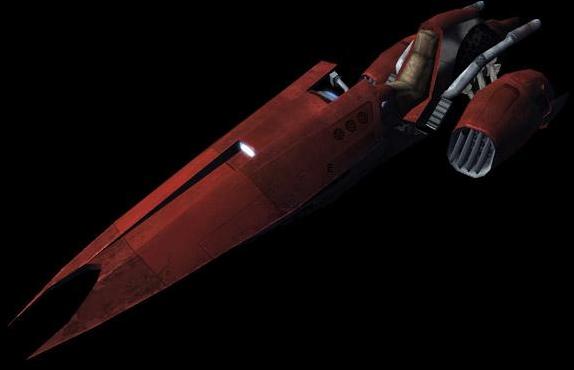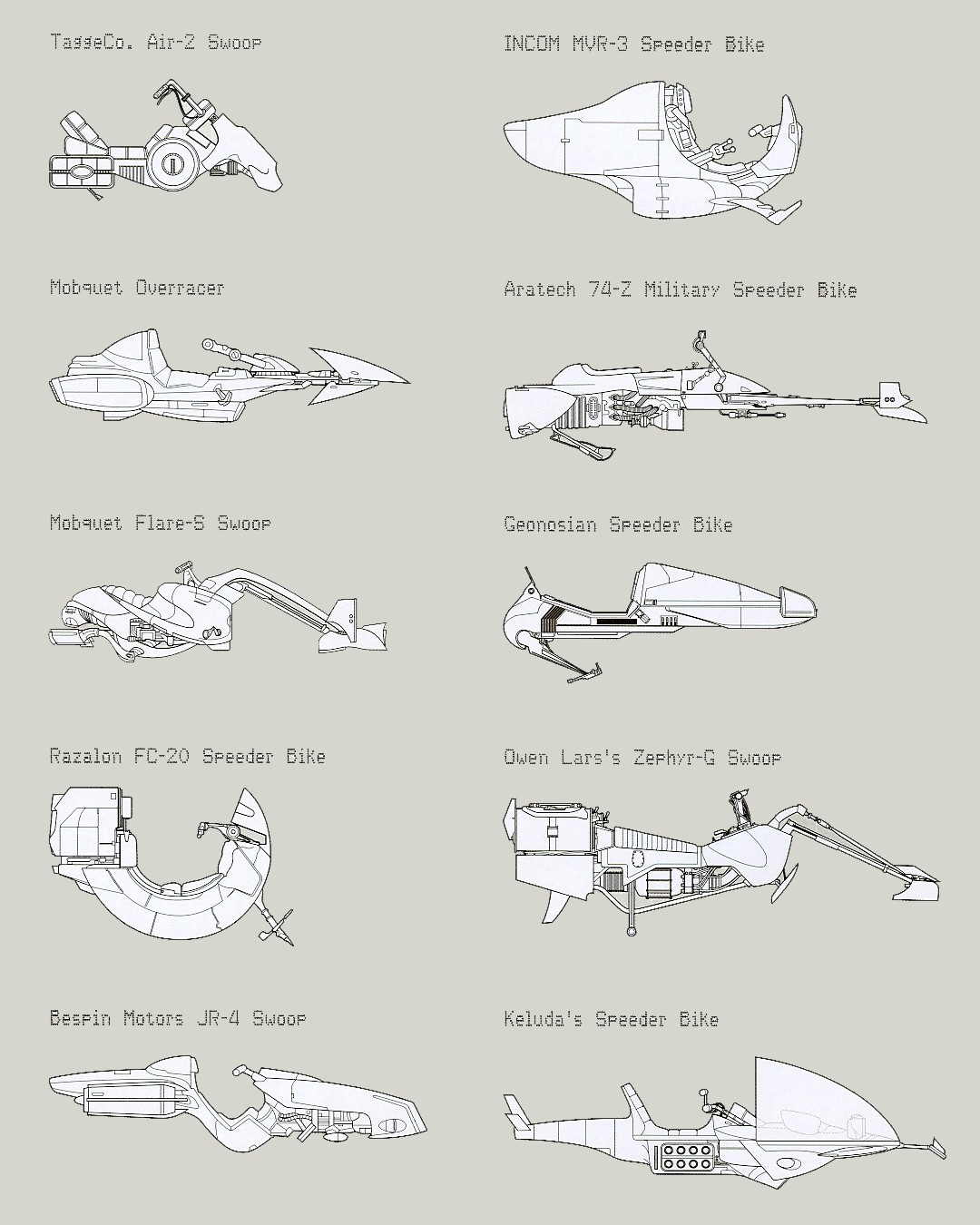Military Hover Bike
Also known as hover cycles, HBs, Tin cans, tin coffins, and smear-bikes, the military hover bike is a common vehicle in many arsenals and motorpools
Appearance
The hover bike is a long vehicle, typically 8 to 12 feet long and has a central seat with a steering system that matches 20th century motorcycles. There are no wheels, so turning the steering assembly is computer calculated to adjust the movement of the bike. The seat also has sensors for a degree or motion capture control, as well as having a standard driving Synthetic intelligence system. Unlike many vehicles with SI or LAI control computers, the bike is mindless and it's computing power is put solely to keeping the vehicle stable and steady, and not rolling and exploding as it would sincerely like to. Power comes from a variety of sources, though most use a high energy fuel cell, while exceptionally high end models mount miniaturized arc reactors. The main hover unit is located on the bottom of the vehicle, while forward movement is managed by a series of small electrofans, basically rendering the hover bike a small wingless aircraft.Â
Star Craft Vulture hover bike
Handling
The hover bike is best known for it's high speed and relatively low cost versus droid vehicles, aircraft, and mecha. It can scout large areas, and cover ground at speeds easily reaching 200+ mph. For this reason, hover bikes are typically only used in open flat areas such as the American Great Plains, the Russian Steppe, the African Savannah, and other similar locations. It's turn radius can be rather large, especially when moving at speed. Critical failures in controlling tests on the hover bike generally involves the bike going out of control, which usually involved the nose digging into the ground and vaulting the vehicle like a football being kicked between the goal posts. It can also be prone to lateral sliding, especially when attempting a hard braking maneuver. Hover bikes are not recommended for beginner troops.

Types and Additions
The most common hover bike is the light scouting model as described above. It is light, fast, fragile, and unarmed. A soldier with a rifle type laser sight or comm scanner can cover a large amount of terrain, lase in targets, relay information and move on quickly.
The standard military hover bike has light armor and usually mounts a light infantry weapon such as a medium machine gun,automatic grenade launcher or the like. It is considerably slower than the scout model, but can still easily do 120+ mph.
The Heavy hover bike has light armor, but additional plating to protect just the rider. It also mounts the forward weapon system. The bike also has a rear mount for a deploying system or cargo pod. The most common use is for a burrowing mine dispenser that can leave a trail of mines rapidly in front of an advancing enemy force. It can also mount a light missile launcher system, electronics warfare pod, or a cargo pod that carries up to 120 pounds of compact gear. The heavy bike can reach 100+ mph but is significantly harder to slow at high speed.
The Armor Hover Bike was built to rapidly transport power armor soldiers without resorting to the bulky and cumbersome transports that such large infantry require. The bike is basically a Heavy hover bike, but has no mounted weaponry and no cargo pod. It is reinforced to handle the weight of a light or medium power armor trooper. The trooper has to supply their own firepower. Most such units function as dragoons, moving quickly to a location, dismounting and then fighting on foot from there. 90+ mph.
Civilian hoverbikes exist, but they are rare. There are no cities or road systems in the cosmic era designed to handle vehicles that move as quickly as the bikes. Most civilian hover bikes are range roving vehicles, sport bikes for overland races, or belong to couriers and other special uses. Unless modified, most are mechanically limited to 75 mph
Sport and Race Hoverbikes occupy a small arena of high risk high speed racing. These bikes are heavily modified and are in most cases little more than seats attacked to engines. Wrecking one of these machines is generally instantly lethal, so hover bike racers are either thrill junkies, cyborgs, or pilot remotely via a surrogate droid. 300+ mph.
Star Wars hover bikes
The Role of the Hover Bike
The Hover bike occupies a small niche in the Cosmic Era. It has a small position in the realm of HoloVids and is much more prevalent in game sims than in real life. The bike has a small role in the military, but it is easily outmatched by surveillance aircraft, drone aircraft, satellite and other data capturing, and the amount of firepower the vehicle can mount is small, even compared to power armor and heavy infantry unit. The speed of the vehicle is rendered not as valuable an asset with the sophistication of guided and homing missiles and the instantaneous speed of lasers and other energy weapons.Â
Hover bikes are most commonly associated with bike gangs, mercenaries and military scouts who want to keep a low profile, or are operating in a data blacked out area.Â
Rule of Cool
Hover Bikes are cool because they are dangerous and fast, and there is something about dangerous fast things that attracts our attention. There are certainly things in the cosmic era faster than a floating jet bike, such as hypersonic aircraft, space craft, and that sort of thing, but none of them are as open and exposed as the bike. High speed bike battles can have riders trading shots with one another, or even fighting each other with melee weapons like infantry hyper edge blades.Â
Not Registered Yet? No problem.
Do you want Strolenati super powers? Registering. That's how you get super powers! These are just a couple powers you receive with more to come as you participate.
- Upvote and give XP to encourage useful comments.
- Work on submissions in private or flag them for assistance.
- Earn XP and gain levels that give you more site abilities (super powers).
- You should register. All your friends are doing it!
? Responses (6)
I had something like this in an old imaginary world of mine, known as the Sky-cutter.
What altitude can the bike reach?
Because, if it can go high enough, it can ignore most terrain, and needs just an open space to land.

this is always my question with hover bikes, what is the flight ceiling, if I ride my hover bike off a cliff how far does it fall. Is the anti-gravity unit or in this case ' main hover unit' sufficient to over come the momentum of the fall? Would it overcome the force of the fall gradually or just stop 1 meter above earth and leave the poor flesh of its rider to deal with the rest of its momentum. Is it really an anti-grave unit, is it a vertical thrust system or magnetic repulsion system? You mention that weight does matter, so is that because of the force of engine. If you are going to re-write the speeder bike and go into all the details of handling, motion predicting, sliding (thus inertia), the little fans that move it forward and how hard they are to use you may as well go all in.
If you are taking the 'I a writer first attitude' and all these technical details are unimportant, than what are we supposed to take away from this in the narrative, emotional sense or cultural relm? Instead you focus on the technical and logistical details, no less creative than the more left brain items imo, but not complete in this version either.
Overall I think the super-cool sci-fi motorcycle is a fun idea that could stand a few retreds before it gets old. But for your cosmic era I think this could have been 100 words.
If you don't want the milk why do you keep posting on the cow?! or something like that
The flight ceiling of the hover bike is 2-3 feet, and no, the lift generated by the unit is not going to overcome the momentum of a significant fall.
You ask some very good questions and make some points. So I want to lay down a challenge to you: retread the hover bike, write your own submission on how it really should be.
I think this submission helps to remind us of details like this, and why it is worth the time to elaborate upon it.
Polished and detailed like the rest of your Cosmic Era stuff. Good work!

